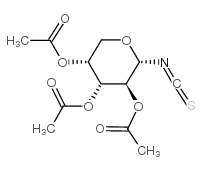2,3,4-tri-o-acetyl-alpha-d-arabinopyranosyl isothiocyanate

2,3,4-tri-o-acetyl-alpha-d-arabinopyranosyl isothiocyanate structure
|
Common Name | 2,3,4-tri-o-acetyl-alpha-d-arabinopyranosyl isothiocyanate | ||
|---|---|---|---|---|
| CAS Number | 62414-75-9 | Molecular Weight | 317.31500 | |
| Density | 1.4g/cm3 | Boiling Point | 401.6ºC at 760 mmHg | |
| Molecular Formula | C12H15NO7S | Melting Point | N/A | |
| MSDS | Chinese USA | Flash Point | 196.7ºC | |
| Symbol |


GHS07, GHS08 |
Signal Word | Danger | |
|
Neural peptidase endothelin-converting enzyme 1 regulates endothelin 1-induced pruritus.
J. Clin. Invest. 124(6) , 2683-95, (2014) In humans, pruritus (itch) is a common but poorly understood symptom in numerous skin and systemic diseases. Endothelin 1 (ET-1) evokes histamine-independent pruritus in mammals through activation of its cognate G protein-coupled receptor endothelin A recepto... |
|
|
Transient receptor potential ankyrin 1 receptor activation in vitro and in vivo by pro-tussive agents: GRC 17536 as a promising anti-tussive therapeutic.
PLoS ONE 9(5) , e97005, (2014) Cough is a protective reflex action that helps clear the respiratory tract which is continuously exposed to airborne environmental irritants. However, chronic cough presents itself as a disease in its own right and despite its global occurrence; the molecular... |
|
|
Corneal sensory nerve activity in an experimental model of UV keratitis.
Invest. Ophthalmol. Vis. Sci. 55(6) , 3403-12, (2014) To produce in guinea pigs a UV-induced keratitis, to analyze the effects of this pathology on corneal nerve activity.In anesthetized animals, one eye was exposed to 254 nm UV-C radiation (500-1000 mJ/cm(2)), excised 24 to 48 hours later and superfused in vitr... |
|
|
Transient receptor potential ankyrin-1 (TRPA1) modulates store-operated Ca2 + entry by regulation of STIM1-Orai1 association
Biochim. Biophys. Acta 1833(12) , 3025-34, (2013) TRPA1 is a non-selective Ca2+ permeable channel located in the plasma membrane that functions as a cellular sensor detecting mechanical, chemical and thermal stimuli, being a component of neuronal, epithelial, blood and smooth muscle tissues. TRPA1 has been s... |
|
|
Effects of acid on vagal nociceptive afferent subtypes in guinea pig esophagus.
Am. J. Physiol. Gastrointest. Liver Physiol. 307(4) , G471-8, (2014) Acid reflux-induced heartburn and noncardiac chest pain are processed peripherally by sensory nerve endings in the wall of the esophagus, but the underlying mechanism is still unclear. This study aims to determine the effects of acid on esophageal vagal nocic... |
|
|
Nitro-oleic acid desensitizes TRPA1 and TRPV1 agonist responses in adult rat DRG neurons.
Exp. Neurol. 251 , 12-21, (2014) Nitro-oleic acid (OA-NO2), an electrophilic fatty acid nitroalkene byproduct of redox reactions, activates transient receptor potential ion channels (TRPA1 and TRPV1) in primary sensory neurons. To test the possibility that signaling actions of OA-NO2 might m... |
|
|
High-performance liquid chromatographic resolution of enantiomers of 1-phenyl-2-aminopropanes (amphetamines) with four chiral reagents.
J. Chromatogr. A. 307 , 335, (1984) High-performance liquid chromatography (HPLC) was employed for resolution of enantiomers of chiral ring-substituted 1-phenyl-2- aminopropanes (amphetamines) and 1-phenylethylamine following derivatization with four chiral reagents: (R)-(+)-1-phenylethyl isocy... |
|
|
TRPA1 is functionally expressed primarily by IB4-binding, non-peptidergic mouse and rat sensory neurons.
PLoS ONE 7(10) , e47988, (2012) Subpopulations of somatosensory neurons are characterized by functional properties and expression of receptor proteins and surface markers. CGRP expression and IB4-binding are commonly used to define peptidergic and non-peptidergic subpopulations. TRPA1 is a ... |
|
|
Induction of quinone reductase by allylisothiocyanate (AITC) and the N-acetylcysteine conjugate of AITC in Hepa1c1c7 mouse hepatoma cells.
Biofactors 26(1) , 7-15, (2006) Cruciferous vegetables contain a series of relatively unique secondary metabolites of amino acids, called glucosinolates, from which isothiocyanates (ITC) can be generated. While glucosinolates are not thought to be bioactive directly, ITC appear to have anti... |
|
|
Inhibitory effects of wasabi isothiocyanates on chemical mediator release in RBL-2H3 rat basophilic leukemia cells.
J. Nutr. Sci. Vitaminol. 58(4) , 303-7, (2012) Wasabi is a plant of Japanese origin. It belongs to the family Brassicaceae and produces various isothiocyanates (ITCs). To clarify the type I allergies inhibited by wasabi ITCs, we investigated the inhibitory effect on chemical mediator release from dinitrop... |